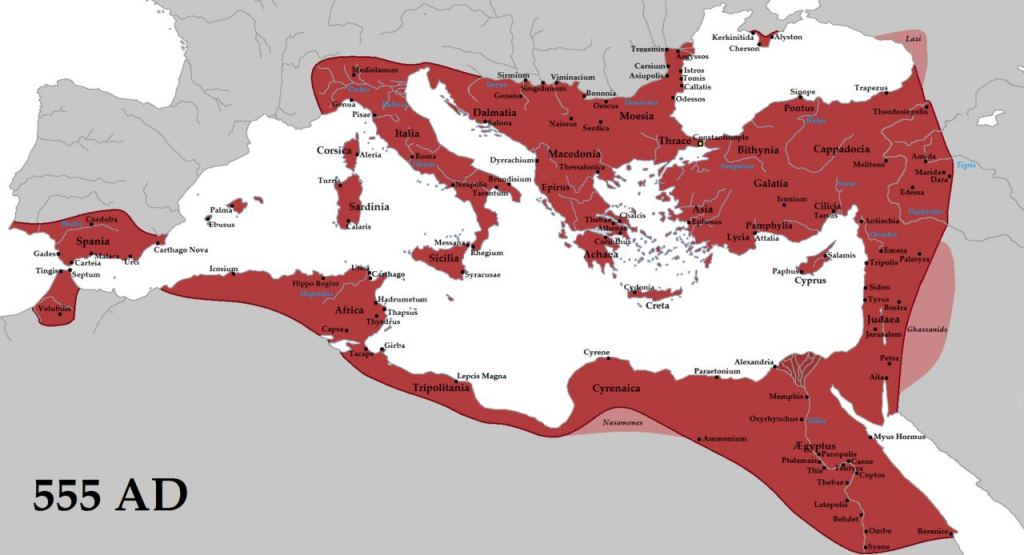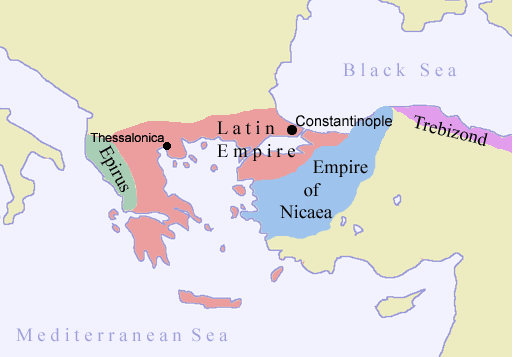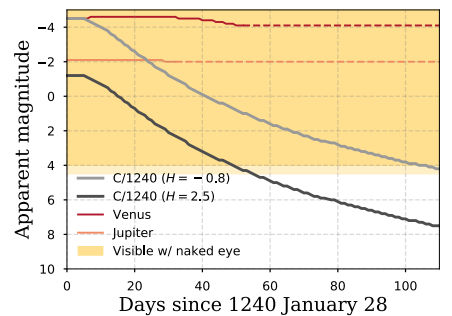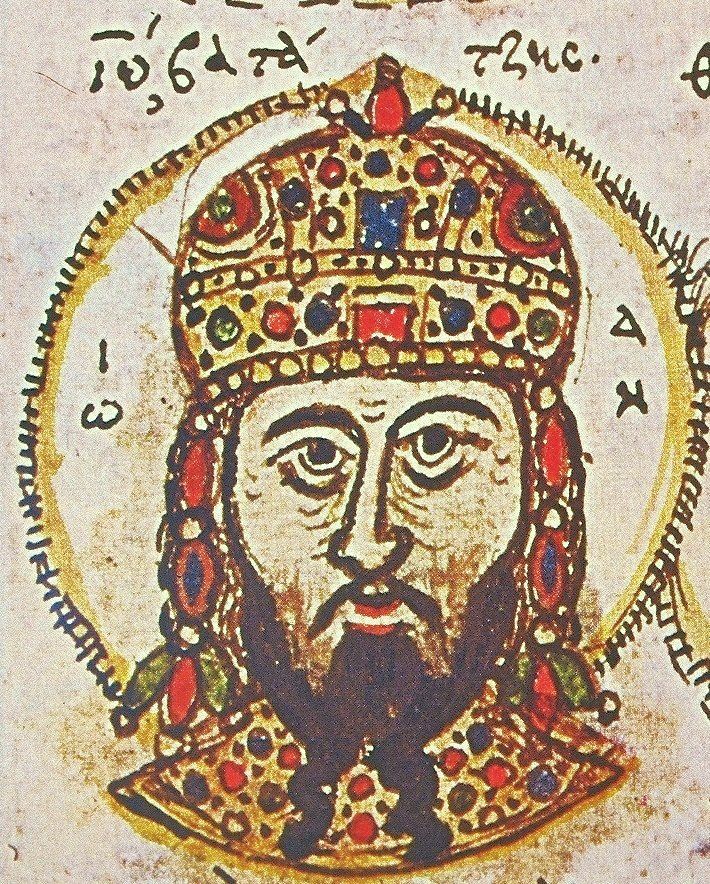Rome was the world’s first mega-empire. At its height it stretched from Western Europe to the Middle East, and over 50 million souls lived within its borders. Some historians think that number could’ve been way higher, up to 100 million.
Rome got its start in the mid-8th century BC. It took centuries for that small city to grow into the Roman Empire, which reached its peak around AD 100. A well-known cliche reminds us how long that took.
But the Roman Empire also took centuries to fracture and dissolve.
During those centuries, what was left of the empire convulsed, shattered, and tried to rebuild itself. Leaders came and went as what was left of Rome was ground down by events and splintered into small rump states.
One of those leaders was Empress Eirene Laskarina, and historians are uncertain when she died. An accurate date for the Empress’ death would shed light on the important events that followed. Now a team of astronomers in Japan have stepped up and used the historical records of comets, combined with modern knowledge, to nail down the date of her demise.
The Eastern Mediterranean region hosted a frothing fermentation of different empires throughout the centuries, and some of what we are today can be traced back to those early civilizations. The break-up of the Western Roman Empire in the 5th century AD led to some of these entities. One such civilization was the Byzantine Empire.

The Byzantine Empire was what was left of the Roman Empire in the Eastern Mediterranean. It was also called Byzantium or the Eastern Roman Empire. The Byzantine Empire survived for another thousand years after the Western Roman Empire fell in the 5th century.
During its thousand years, Byzantium went through a lot of strife. In the early 1200s, crusaders occupied Byzantium’s capital Constantinople, and the empire was broken into three rump states. The Byzantium aristocracy fled and formed one of those rumps, called the Empire of Nicaea. The Laskaris family founded it, and the Empire lasted a few decades, from 1204 to 1261. The Nicaean Empire came to an end in 1261, when the Nicaeans successfully restored the Byzantine Empire in Constantinople, with Empress Eirene’s help.

But before Empress Eirene’s time, the Eastern region was what we might call a hot mess.
After the crusaders occupied Constantinople and Byzantium was split into three, Mongol invaders arrived in the region in 1242-1243. They weakened Nicaea and stripped the rump empire of territory. The Seljuk Turks were also actively aggressive towards Nicaea. From our perspective, the whole neighbourhood looked like a messy kaleidoscope of leaders, peoples, and events, as different empires and kingdoms fought with each other, and as territories were gained and lost.

This is where Eirene Laskarina enters the picture. Eirene was heir to the Nicaean throne, and after her first husband died, her father married her in 1216 to a very successful soldier from a military family. His name was John III Batatzes.
Though Batatzes became the Nicaean Empire’s titular leader and wielded the power, Empress Eirene was actively involved in governing. Together, Batatzes and Eirene were able to build mostly friendly relations with their neighbours. Eirene is also given credit for being a modest and prudent Empress and bringing about a “considerable improvement in her nation’s morals.” According to historical accounts, she was held in high regard by the people.
Eventually, the Nicaean Empire reestablished the Byzantine Empire in Constantinople in 1261. That was a major event in the region, and though Empress Eirene had died some two decades before that, she played a role in that eventual reestablishment. To understand the events of those times and Eirene’s role in them, historians have worked to determine the date of her death. Collectively, historians have determined that she died sometime between late 1239-1241.
That’s where this new research comes in. The paper is titled “Cometary records revise Eastern Mediterranean chronology around 1240 CE.” The lead author is Koju Murata of the Institute for Advanced Research at Nagoya University. The paper is available on the pre-press site arxiv.org.
Then, as now, events in space provide a kind of historical calibration for events on Earth. In Empress Eirene’s case, their observations of comets near her time of death can help establish exact dates. But sometimes, historical observations are unclear. The ancients weren’t always rigorous in their observations and conclusions, and they also knew much less about the cosmos.

George Akropolites was a famous civil official in the Byzantine period. He was also a historian and wrote a book called Chronographia, or Annals. That book covered the time period from the Crusader occupation of Constantinople to the recapture of Constantinople by the Nicaeans. In that book, he ties Empress Eirene’s death to the appearance of a comet six months earlier.
The problem is, there are two comet candidates in the historical record that could have fit the bill.
In their paper the authors write that “George Akropolites, a famous official of the Empire, gives an account that connects Eirene’s death to a comet that appeared ‘six months earlier’, thus pointing to two comet candidates that were visible from the Eastern Mediterranean between 1239 and 1240, one recorded on ‘3 June 1239’ and the other on ‘31 January 1240’.”
They point out that in recent times, historians have favoured the 1240 candidate, which then places Empress Eirene’s death at sometime around July 1240. But is this accurate?

The team from Japan took another look. They thought the historians’ preference for the 31 January 1240 comet is historical and not based on a rigorous assessment of the evidence. Could it be confirmed?
The 1239 date was actually a partial solar eclipse that Eirene herself witnessed. The May-June 1240 date is the latest possible date that Eirene’s husband could have remarried. So somewhere between the two was her actual passing.
This is why identifying the comet that Akropolites referenced is critical. In their paper, they write: “Thus, it is crucial to identify this comet in order to fix the chronology. In that vein, this comet has been controversially identified with two different astronomical reports that Grumel (1958) catalogued as having occurred on ‘3 June 1239 ([observed in] Europe)’ and ‘31 January 1240 ([observed in] general)’.”
The team of researchers consulted different historical accounts of comets from around the world. First, they considered the 1239 sighting.
A Japanese account said that “On Day 23 in the 4th month [= 27 May 1239 in the Julian calendar], a fair sky. Ghostly vapour was observed in the northwest during the hour of the dog [= 7 p.m. to 9 p.m.].”

A written account from Cremona said “On 3 June [1239], a bearded star together with a celestial object such as a torch was observed, which made haste to the west. They presaged a serious lack of provisions shortly after, and infinite things perished.”
The astronomers behind this research think that these accounts describe something other than a comet, possibly a meteor. “Its quick motion, localized appearance, and the plausibility of its short duration
are all characteristics that are more consistent with meteors or bolides. Meteors have long tracks, and when they are bright enough, they are often compared with torches and beams.” They also point out that some meteors can be brighter than the full Moon.
Next, the Japanese researchers considered the accounts from the year 1240. “Various contemporary writers across the Eurasian continent made records of the comet that was first discovered in the end of January,” they write. The authors also consulted a well-known Japanese chronicle called Azuma Kagami.

represents the theoretical light curve of C/1240 B1 assuming the fiducial absolute magnitude of H=2.5, and Venus matched magnitude of H=-0.8, which is based on the description of Azuma-Kagami. The apparent magnitudes of Jupiter (m~-2.1 to -2.0) and Venus (m~-4.5 to ~-4.1, which depends on the observing dates) are also shown with orange and red solid-line, connected with the dashed-line where Jupiter/Venus is not
visible in the night. The yellow area represents the visible area with the naked eye (limiting magnitude of m=4~4.5). Image Credit: Morata et al 2020.
That comet is called C/1240 B1 and is considered one of the Great Comets. That just means it was exceptionally bright and easily seen with the naked eye. Its existence is confirmed in multiple accounts from around the world.
The Japanese team concluded that Akropolites’ comet is C/1240 B1 and that its appearance sets the Empress’ date of death. According to them, Empress Eirene’s death occurred in the summer of 1240, about six months after the comet appeared.
Knowing the date of Eirene’s death confirms other political figures’ death, most notably a pair of leaders from two neighbouring kingdoms. It also confirms when her husband, Byzantine Emperor John III Batatzes, married his new wife. It’s beyond this article’s scope to explain this in great depth, but knowing Eirene’s actual death date has a cascading effect on understanding the region’s shifting power dynamics and how Eirene’s family eventually reconstituted the Byzantine Empire in Constantinople.
After Eirene died, her husband remarried to consolidate his power alliances, which helped keep the Mongol’s at bay. Also, Pope Gregory IX had excommunicated Batatzes, and Batatzes needed powerful alliances to curtail the hostility that the Pope felt toward him. It’s also worth noting that when Empress Eirene died, the people grieved. But when her husband remarried so soon after her death, the peoples’ sentiments turned against him.

Ultimately, all of these kingdoms and empires fell. As far as the Roman Empire goes, some say the Roman Catholic Church is the final rump of the long-gone empire. So events from hundreds of years ago have echoed down through the ages. The Pope is still revered by upwards of one billion people.
Events in space are one of our only tools for confirming some ancient accounts and helping piece together our fractured accounts of human history. As the researchers write in their paper: “Astronomical phenomena recorded in various past periods all over the world have sometimes been regarded as keys to determining the dates of major historical events that have been associated with these phenomena in historical writings;” They also point out that astronomical events can confirm the accuracy of the historical writings themselves.
As for the comet at the center of this story, C/1240 B1, not much is known about it. It hasn’t reappeared, and the spotty observations from 1240 aren’t enough to allow astronomers to predict its next visit to the inner Solar System. It may take thousands of years to return, or even millions. Or it may never return.
It’s somewhere out there in space, doing what comets do: marking the passage of time, oblivious to human affairs.


Great article.